|
Tule
Ponds at Tyson
WATER BIRDS
|
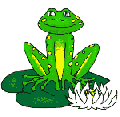 |
|
Water birds include those families of birds of which most or all
members are associated with open water or wetland habitats. |
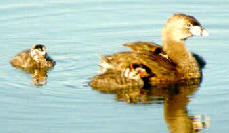 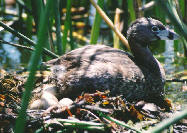 Pied-billed Grebe Pied-billed Grebe
Podilymbus podiceps
The
pied-billed grebe appears brown to the observer because its white
belly does
not show above the water surface. Its neck is almost as
thick as its head. In spring and summer adults have a black throat
and a black band around the whitish bill (pied). Grebes have no
evident tail. Their large feet are positioned far back on the body
to streamline them and enable them to be powerful swimmers and
divers. They swim low in the water and sink or dive underwater to
pursue prey such as fish, crustaceans, aquatic snails, aquatic
insects, nymphs, water boatmen and water beetles. They can remain
submerged for a long time. They take off from water after a long
run on the surface. Grebes are helpless on land. They build
floating nests so they will not be flooded and so young grebes will
be able to reach the water when they are ready to fly. |
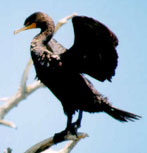 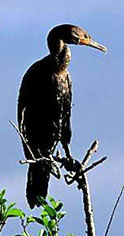 Double-crested Cormorant Double-crested Cormorant
Phalarocrocorax auritus
This is the
only one of the three species of cormorants occurring in California
that occurs regularly on fresh water. Adult double-crested
cormorants are brownish-black with a green gloss. In spring they
have short curled crests on the head. They swim low in the water
with the tail near or at the surface and the hooked bill tipped up.
When taking flight, they kick along the surface of the water with
webbed feet or drop from a perch. They are often seen perching
with their wings spread to dry them in the sun. They dive
underwater to catch fish or small crustaceans. In China, fishermen
place a ring around a cormorant’s neck so that it cannot swallow the
fish it catches. Cormorants nest in trees or on rock ledges. |
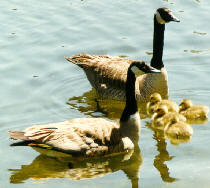 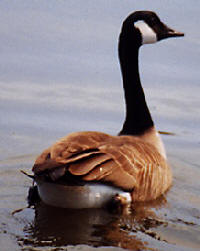 Canada Goose Canada Goose
Branta canadensis
Canada geese are
called “honkers” because of the sound they make in flight. The
Canada goose is a dark goose with a brownish body and wings, white
lower body and black head, neck and tail. It has a distinctive white
chin-strap. Geese ride high in the water, tipping up to feed.
Unlike ducks, geese pair for life. The female goose usually raises
one clutch of 4 to 7 large eggs laid from mid-March to June in a
grassy nest placed on ground where there is good all-round
visibility. Canada geese nest on the levee at Tyson’s Lagoon. The
gander (male) vigorously defends the nest and surrounding area. Some
birds may double brood, resulting in a rapid increase in their
numbers. Canada geese are very social birds and have adapted so
well to urban habitats that they have become pests in local parks
and lakes. |
|